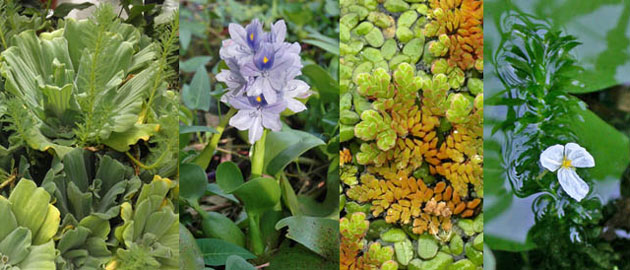
Aquatic Plants
Although all plants require some water to live, some can tolerate or even require liquid water throughout their lifetime. Very few embryophytes (land plants) can tolerate saltwater, an exception being the seagrasses (Zostera). Most aquatics occur in freshwater environments. These plants can be placed into three general categories based on their overall habit:
- Emergents. Plants with some portions partially submerged in water, the other parts growing in the air above the water.
- Submergents. Plants with all parts totally submerged.
- Floating. Plants floating on the surface of the water, not rooted.
There are many native and non-native aquatic plants that could be listed here, but we will consider only the ones that are commonly seen in cultivation and ones that we actually have in the SIU Greenhouse.
Emergents
- Acorus gramineus. The native species of Sweet Flag has been used to make candy from its rhizome. This species (variegated variety) is purely ornamental.
- Cyperus. The most commonly seen species is C. alternifolius, the Umbrella Sedge. This species is similar to C. papyrus, famous for being the source of the writing material papyrus.
- Hydrocotyle. Although these plants can be grown in a regular pot, many species of Pennywort like to have their feet wet! The plants grow by means of a rhizome with the peltate leaves occurring at various intervals.
- Juncus effusus. This species (and other Juncus as well) have become popular plants for landscaping, especially in outdoor pools. Some varieties have straight leaves whereas others are contorted (twisted).
- Marsillea. Water Fern, Four Leaf Clover. Upon first glance, this plant looks like a Four Leaf Clover (a legume), but is in fact a fern.
- Myriophyllum. The Water Milfoils have highly dissected leaves that occur submerged but the stems can also produce aerial portions whose leaves look very different (heterophylly). The flowers and fruits are borne on the aerial portions. Species are notoriously difficult to distinguish.
- Sagittaria. Several species are cultivated, such as S. montevidensis.
Submergents
- Ceratopteris thalictroides. The Water Sprite is another aquatic fern. This species is a valuable model research organism because it can be easily grown.
- Elodea. This popular aquarium plant (also called Anacharis, Egeria, Brazilian Waterweed) has its stems and leaves totally submerged, but the flowering stalk stretches to the water surface where the flower occurs.
- Isoetes. The Quilworts are classified as lycophytes, an early branching clade often allied with the ferns. Many species are emergents in nature but strangely don't object to being grown as submergents.
Floating
- Azolla. These floating ferns are sometimes called Water-Velvet. The fronds are branched, often radiating from a single point. Interestingly, these fronds often support a symbiotic partner - a cyanobacterium. Because the bacterium can fix atmospheric nitrogen, Azolla plants are often purposely planted on rice paddies in Asia to naturally fertilize the field. However, huge mats of it can compete with other native aquatic plants and animals by blocking the sunlight and reducing oxygen availability. They also block irrigation pumps, and sometimes cause deaths (by drowning) to livestock that mistake the Azolla mats as soil. See web page HERE for more on control of this plant.
- Eichhornia crassipes. The Water Hyacinth is an example of too much of a good thing. Originally from South America, the plant was brought to a flower show in Florida where it escaped a backyard pond. The rest is history. The plant now clogs numerous waterways in Florida (and other parts of the world too) where millions or dollars are spend on control. The plant floats by means of its spongy, air-filled petioles. A dense mass of roots dangles into the water below the plant. The flowering stalks are aerial producing beautiful blue flowers.
- Lemna. Duckweeds are ubiquitous components of any freshwater pond or lake, being dispersed by waterfowl. The floating "thallus" of the plant is tiny, sometimes with a root protruding downward into the water. Other aquatic relatives in the family include Spirodela, Wolffia and Wolffiella.
- Pistia stratiotes. This member of the arum family, called Water Lettuce, is native to Lake Victoria in Africa. It has been introduced into many freshwater environments worldwide and can become quite invasive. As with Salvinia, it's leaves are bouyant owing to a dense covering of hairs.
- Salvinia. The Floating Moss (not a moss!) is actually another fern, like Azolla. It's fronds are round in shape and covered on the top surface with amazingly tall hairs (trichomes) that branch at the tip. These effectively trap air making the leaves very bouyant.
Aquarium Plants
A number of different plants are sold commercially for use in aquaria. Some of these are true aquatics and others are simply plants that can be grown as aquatics, even if they are not usually seen this way in nature.
- Aponogeton madagascariensis. Aponogetonaceae. Madagascar Lace Plant
- Anubias barteri. Araceae. Anubius.
- Anubias congensis (= A. afzelii). Anubius.
- Anubias hastaefolia. Anubius, Hastate Leaf.
- Anubias nana. Anubius, Dwarf.
- Bacopa monnieri. Plantaginaceae. Moneywort.
- Cabomba caroliniana. Cabombaceae. Cabomba.
- Ceratophyllum demersum. Ceratophyllaceae. Hornwort.
- Cryptocoryne crispatula. Araceae. Balansae Plant.
- Cryptocoryne spiralis. Spiralis.
- Cryptocoryne wendtii. Cryptocoryne.
- Echinodorus amazonicus. Alismataceae. Amazon Sword Plant.
- Echinodorus cordifolius Radican Sword, Marble Queen.
- Echinodorus martii. Ruffle Plant.
- Echinodorus osiris. Melon Sword.
- Echinodorus tenellus. Chainsword Narrow Leaf.
- Eleocharis acicularis. Cyperaceae. Dwarf Hairgrass.
- Hygrophila angustifolia. Acanthaceae. Temple, Narrow Leaf.
- Hygrophila corymbosa. Temple, Corymbose.
- Hygrophila difformis. Wisteria.
- Lilaeopsis novae-zelandiae. Apiaceae. Micro Sword.
- Ludwigia glandulosa. Onagraceae. Ludwigia Peruenis.
- Ludwigia inclinata. Ludwigia Inclinata.
- Ludwigia repens. Ludwigia, Broad.
- Microsorum pteropus. Polypodiaceae. Java Fern.
- Myriophyllum heterophyllum. Haloragaceae. Myrio-Red.
- Myriophyllum pinnatum. Myrio-Green
- Nymphoides aquatica. Menyanthaceae. Banana Plant.
- Rotala indica. Lythraceae. Rotala Indica.
- Rotala macranda. Rotala Magenta.
- Sagittaria platyphylla. Alismataceae. Arrowhead, Flatleaf.
- Sagittaria subulata. Dwarf Sagittaria.
- Spathiphyllum tasson. Araceae. Brazilian Sword.
- Vallisneria americana. Hydrocharitaceae. Corkscrew Vallisneria.
